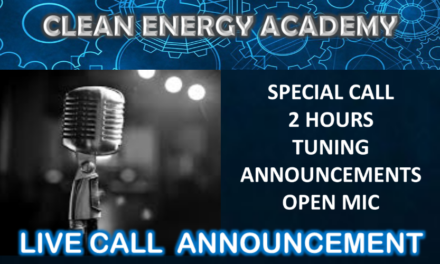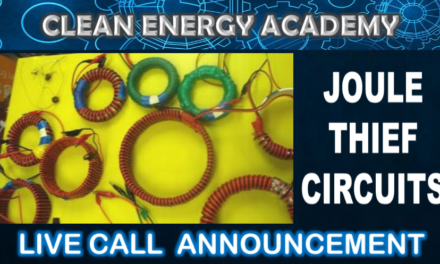The QEG is the most heavily trolled and oppressed energy device on the internet. The QEG is an alternative electric energy generator that was designed based on the work of Nikola Tesla. It is intended to provide power to your home without the need of fossil fuels. In 2014 James Robitaille along with his wife Valerie Robitaille and step-daughter Naima Feagin (also known as Hopegirl) crowdfunded and open sourced the first prototype on the internet. The plans which were originally given away for free were downloaded by over a quarter of a million people.
Watch the new video here on Youtube:
Or watch the new video here on Vimeo
What is the QEG Project Hopegirl QEG from Hope Moore on Vimeo.
From the very first day of this project, the intention was to build this device and invite others to build it and codevelop it together. It is an opensourced device, which simply means that there are no patents on this device and no one owns or controls the design. Currently in this industry, all new innovations are locked up with patents and not available to the public. This is one of the things that makes the QEG so unique. Using his decades of professional engineering experience, James Robitaille built and wrote out a build manual to bring the device into a state of producing power through a phenomenon called resonance. This is another aspect that makes the QEG unique as no other machines utilize resonance in this way to create electrical power. The plans written by James were accurate enough to allow hundreds of others to replicate and build the device and bring it into resonance in many countries around the world. Building a device that can achieve resonance and produce an enormous amount of electrical power is a tremendous milestone. The next phase is trying to figure out how to control that power and direct it in such a way so that you can use it to power your home and appliances. This phase is what many builders around the world have been working on co-developing together to complete the QEG.
The project went private in July of 2015. This means, that all further developments, innovations and reporting on the device would no longer be done in a public manner, but rather all of this would be conducted through a private members platform known as the “Clean Energy Academy”. This was done to protect the integrity of the engineering work done on the project and provide builders with a safe environment to freely share their research and development information.
Privatization was a necessary stage in the project as the family and the project has received the largest onslaught of online slander campaigns ever experienced by any other energy device on the internet. Public information such as schematics and building plans once given away freely were taken by malicious parties, heavily edited, and then sold to an unsuspecting public as the originals. Huge disinformation campaigns to try to discredit the QEG technology were launched across several trolling websites with dozens of slanderous articles, hundreds of youtube videos, and literally thousands of comments from sock puppet accounts in dedicated anti-QEG forums.
The reason for such a strong opposition to the QEG are very clear: The QEG is a REAL energy device that is a threat to the oil industry and it can’t be controlled because its open sourced and the plans have already been dispersed to a quarter of a million people.
QEG System Description
The Quantum Electric Generator system (QEG) is an adaptation of one of Nikola Tesla’s many patented electrical generator / dynamo / alternator designs. The particular patent referenced is No. 390,414, titled “Dynamo-Electric Machine”, and dated October 2, 1888.
The QEG prototype is scaled to produce electrical power in the range of 10-15 kW (kilowatts) continuously, and can be wired to provide either 120 Volt or 230-240 Volt single phase output. We are also planning future designs to provide 3-phase power.
Service life of the device is limited only by certain replaceable components, such as bearings, v-belts, and capacitors. The basic machine should operate trouble-free (with minimal maintenance) for as long as any good quality electro-mechanical appliance, such as a quality washing machine or refrigerator. Heavy-duty mechanical components are used throughout for reliability. The QEG is not a complicated device, as it is designed (like Tesla’s other ‘discoveries’), to work in harmony with natural laws, rather than with the power-wasting symmetric motor and generator designs used in today’s mainstream industry.
An effective way to understand the operating principal of the QEG is to think of it as a high-powered self-resonant oscillator (what they used to call a ‘multivibrator’), adapted to transform high-voltage pulses (15 to 25kV) into line voltage AC output, at current levels up to 120A. In today’s alternative energy terminology, it would be a type of resonance machine.
The circuitry that develops high power in this device is really based on an existing but under-utilized power oscillator configuration, however, the ‘quantum’ part of the design has to do with how the generator is started. Conventional alternators (AC generators) usually have a device called an ‘exciter coil’. This coil is usually a smaller, separate rotor winding that provides an AC voltage that is rectified and used to power the generator’s field coil(s).
In the QEG, there is no internal, common exciter coil, and no rotor windings. In addition, to look at the circuit diagram, it is not apparent where the input power comes from to start resonance, and this is key; the QEG exciter coil is external to the generator, and the excitation signal is conducted through the quantum field (zero point) into the generator core, to start oscillation. Once the machine builds up to the resonant frequency, it powers itself (self running).
-James M. Robitaille
If you want to get involved or contact Hopegirl or learn more about the project Join the Clean Energy Academy here: http://qegfreeenergyacademy.com/join/ On the academy you can get the build plans for the QEG, the CAD package for the mini QEG, join us on live calls twice a month, and also have access to our full library of schematics, building instruction videos, test and measurement reports, project reports and much more.













